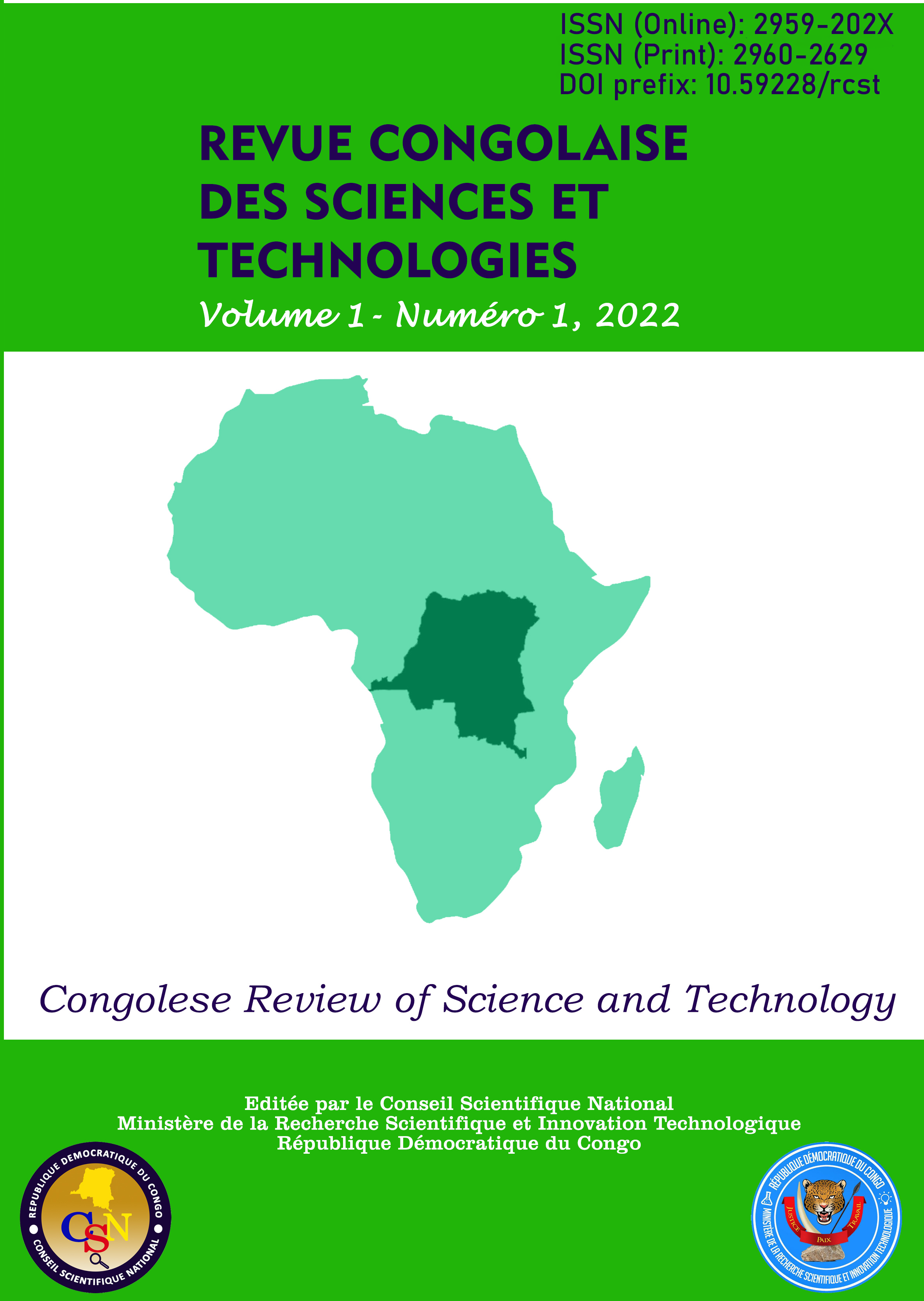Comparative Study of the Colonizing Flora of the Thermal Water Neighborhood in the Vicinity of the Bukavu City (South Kivu)
Main Article Content
Abstract
This study contributes to the knowledge of the diversity of flora and the updating of plant data from thermal water sites in eight sites (Burhinzi, Luhwindja, Kankulé, Kakonde, Cimenki, Cizirhi, Buhandahanda, Nyangezi) located in the vicinity of Bukavu city. The phytosociological method was used in a 10 m sampling area on either side of the site, in which two 4 m2 surveys were conducted. The sampling method consisted of a quantitative inventory to identify the various specific abundances. The results show an inventory of the plant species present in the thermal sites grouped into 33 families of 83 genres and 101 species of which the families of Asteraceae, Poaceaeand Fabaceae are the most abundant. Herbs dominate trees and most of the flora studied is found in therophytes. Comparison of the specific richness between the different sites based on the ANOVA test shows that there is no significant difference between the sites (P > 0, 001; F=1,881).
Keywords: Thermal waters, quantitative inventory, floral diversity, specific abundance, Bukavu, South Kivu
Article Details

This work is licensed under a Creative Commons Attribution-NonCommercial-ShareAlike 4.0 International License.
References
Bagalwa, M.L., Mashimango, J.J., Mateso, B., Katcho, K., Kaboyi, I. (2015). “Caractérisation Physico-Chimique et Identification Des Espèces Végétales Indicatrices Des Eaux Thermales de Katana , Sud Kivu , République Démocratique Du Congo Résumé Abstract.” Afrique SCIENCE 11 (5): 406–21.
Bagalwa, M.L., Mateso, L., Mashimango, B., Katcho, K. (2015). “Hydrochemical Characterization of Katana Thermals Waters, Lake Kivu Watershed.” Scholars Journal of Engineering and Technology 3 (1B): 98–103.
Barnby, M.A, Resh, V.H. (1988). “Factors Affecting the Distribution of an Endemic and a Widespread Species of Brine Fly ( Diptera : Ephydridae ) in a Northern California Thermal Saline Spring.” Entomological Society of America 81: 437–46.
Brues, B.Y., Charles, T. (1927). “Animal Life in Hot Springs.” Quar. Rev.Biol 2 (2): 181–203.
Collins, B.G., Brian, G., Rebelo, T. (1987). “Pollination Biology of the Proteaceae in Australia and Southern Africa.” Australian Journal of Ecology 12: 387–421.
Ervin, G.N., Brook D. H., Bried, J.T., Holly, D.C. (2006). “Evaluating non-native species and wetland indicator status as components of wetlands floristic assessment.” Wetlands 26 (4): 1114–29.
Kabonyi, N.C. (2012). “Analyse Palynologique de Divers Sondages Du Secteur Haute Altitude Du Parc National de Kahuzi- Biega. Paleoenvironnements et Paléoclimats Au Pleistocène Supérieur et à l’Holocène.”
Letouzey, R.G. (1989). “Spécialiste Incontesté de La Botanique Des Forêts Du Cameroun.” In Hommes et Destins, 479–81.
Maki, M.J.C., Dewitte, O. (2014). “Towards an Inventory of Landslide Processes and the Elements at Risk on the Rift Flanks West of Lake Kivu ( DRC ).” Geo-Eco-Trop 38 (1, s.): 137–54.
Villeneuve, M. (1980). “La Structure Du Rift Africain Dans La R6gion Du Lac Kivu (Za~re Oriental).” Bull. Volcanol 43 (3).
Vincent, W.F., Howard, W.C., Tildesley, P., Butler, E., (1991). “Distribution and Biological Properties of Oceanic Water Masses around the South Island , New Zealand.” New Zealand Journal of Marine & Freshwater Research 25: 21–42. https://doi.org/10.1080/00288330.1991.9516451.
Winterbourn, M.J. (1969). “The Distribution of Algae and Insects in Hot Spring Thermal Gradients at Waimangu , New Zealand.” New Zealand Journal of Marine & Freshwater Research 3: 459–65. https://doi.org/10.1080/00288330.1969.9515311.
Winterbourn, M.J., Brown, T.J. (1967). “Observations on the Faunas of Two Warm Streams in the Taupo Thermal Region.” New Zealand Journal of Marine & Freshwater Research 1 (1): 38–50. https://doi.org/10.1080/00288330.1967.9515190.
Alayat, H., Lamouroux, C. (2007). Caractérisation physico-chimiques des eaux thermo-minérales des monts de la Cheffia (extrême Nord-Est Algérien). PressTherm. Climat. 144: 191– 199.
Barnby, M.A., Resh,V.H. (1988). Factors affecting the distribution of an endemic and a Widespread Species of brine fly (Diptera: Ephydridae)in a Northern California Thermal Spring. Annals of the Entomological society of America 81: 437-446.
Braun-Blanquet, J. (1932). Plant sociology. The study of plant communities, McGraw-HIL Book Company, Inc., New York, 407 p.
Brues, C.T. (1924). Observation on animal life in the Thermal waters of Yellowstone Park, with a consideration of the thermal environment, proceeding of the American Academy of Arts and Sciences 59, 371-437.
Brues, C.T. (1927). Anaimal life in the hot Spring. Quarterly Review of Biology ,2, 181-203.
Brues, C.T. (1932). Further Studies on the fauna of North American hot Springs. proceeding of the American Academy of Arts and Sciences 67: 186-303.
Ervin, G.N., Herman, B.D., Bried, J.T., Holly, D.C. (2006). Evaluating non-native species and wetland indicator status as components of wetlands floristic assessment. Wetlands 26 :114-129.
Fischer, E. (1993). La végétation du Parc National de Kahuzi-Biega (Sud-Kivu/Zaïre). Bonn, 93p.
Gotelli, N.J., Colwell, R.K. (2001). Quantifying biodiversity: procedures and pitfalls in the measurement and comparison of species richness. , Ecol. Lett. 4: 379-391.
Hammer , ø., Harper, D.A.T. , Ryan, P.D. (2016). Past, paleontological statisticssoftware package for education and data analysis. Palaeontologia Electronica 4(1): 9.
Jaze-Charvolin, M. R. (2014). «Les stations thermales : de l’abandon à la renaissance. Une brève histoire du thermalisme en France depuis l’Antiquité », In Situ [En ligne], 24 | 2014, http://journals.openedition.org/insitu/11123 ; DOI : 10.4000/insitu.11123
Letouzey, R. (1982). Manuel de botanique forestière de l’Afrique Tropicale. Tome 1, Centre technique Forestier Tropical.
Mapenzi, A. (2010). Contribution à l’étude floristique dans le secteur de Tshivanga.
Mashimango, B., Majaliwa, J.G.M., Mushagalusa N., Karume, K.. (2013). Estimation of transported pollutant load from small urban Kahuwa river micro-catchment in Lake Kivu, Democratic Republic of Congo. Journal of Environment Science and Engineering B 2 460 - 472.-[17].
Mashimango, B. , Mateso, B., Katcho, K. , Kaboyi, I., Malengera, K., Nteranya, B., Ntadumba , N., Cinyambiriri, B. (2015). Caractérisation physico-chimique et identification des espèces végétales indicatrices des eaux thermales de Katana , Sud Kivu , République Démocratique du Congo, Afrique Science 11(5): 406- 421.
Mashimango, B., Bagalwa, M., Karume, K. (2015). Hydrochemical characterization of Katana thermals waters, Lake Kivu watershed. Scholars Journal of Engineering and Technology, 3 (1B) 98 – 10.
Mitchell, R. (1974). The evolution of thermophily in hot Springs . Quartely Review of Biology, 49, 229-242.
Ouali, S., Mehmah, B., Malek, A. (2007). Etude de faisabilité d’utilisation des eaux thermales de Zelfana Dans la Production d’Hydrogène. 2IWH, Ghardaïa - Algeria, 9p.
Pielou, E.C. (1996). Species diversity and pattern in the study of ecological succession. Theor. Biol.10: 370-383.
PNKB, Sud-Kivu, RD Congo.annales des sciences de l’UOB , vol. 2. 2010.
Schoeman, F.R., Archibald, R.E.M. (1988). Taxonomic notes on the diatoms (Bacillariophyceae) of the cross Barmen Thermal Springs in south West Africa /Namibea. South African Journal of Botany 54: 221-256.
Senterre, B. (2005). Recherches méthodologiques pour la typologie de la végétation et la Phytogéographie des forêts denses d’Afrique Tropicale. Thèse de doct. ULB. Labo. Bot. Syst. &Phyt. 345p. + Annexes.
Shanonn, C.E., Weaver, E.W. (1949). The mathematical theory of communication. Univ. of Illino.
Simpson, E.H. (1949). Measurement of diversity, Nature 163: 688.
Staruhlner, F. (1969). Beitrage zur kenntnis der biozonosen islandischer thermalge wasser. Sitzungsberichte osterreichische akademie der wissenschaften.Mathematish–Naturxissenschaftliche Klasse. Abteilung I, 178: 83-173.
Stirling, G., Wilsey, B. (2001). Empirical relationships between species richness, evenness and proportional diversity. Am. Nat. 158: 286-299.
Stockener, J.G. (1968). Algal growth and primary productivity in a thermal stream. Journal of the Fischeries Research Board of Canada, 25, 2037-2058.
Stockener, J.G. (1971). Ecological energetics and natural history of Hedriodiscus truqui( Diptera) in two Thermal Spring communities. Journal pf the Fisheries Research Board of Canada 28: 73-94.
Tuxen, S.L. (1944). The hot Spring, their animal communities and their zoogeographical significance. In the zoology of Iceland, vol. 1, Part II, 1-216. Ejnar Munksgaord, Copenhagen.
Vincent, W.F., Forsyth, D.J. (1987). Iland waters of New Zeland . PP. 349-375. DPSIR. Science information publishing center, Wellington.
Vouk A. (1919). Biolog. Unters. ThermalquellenKroatiens and Slavoniens. Bullet. Acad. d. Sc. Slav. du sud. Zagreb, 5 (191G), 8.
Vuathier, CH. (1926). Notes sur la flore thermale des eaux sulfureuses de Mérens (Ariège), Bulletin de la Société Botanique de France 73:3, 388-398, DOI: 10.1080/00378941.1926.10833594.
Wiegert, R.G. (1973). A general ecological model and its use in stimulating algal- fly energetic in a thermal Spring community. In :Insects : stydies in population Management (P.W.Geier, L.R.Clark, D.J.Anderson & H.A.Nix, eds), 85-102.Ecology Society of Australia(Memoirs1), cauberra.
Winterbourn, M.J. (1968). The faunas of thermal waters in New Zealand. Tuatara 16: 111-122.
Winterbourn, M.J. (1969). The distribution of algae and Insects in hot spring thermal gradients at waimangu, new Zealand. New Zealand journal of Marine and Freshwater Research 3: 459-465.

